
Ultimate Checklist for Buying Cardboard Cremation Boxes
Why Cardboard Cremation Boxes Are the Smart Choice for Modern Funeral Homes
Cardboard cremation boxes are lightweight, eco-friendly containers designed to hold human remains during the cremation process. These biodegradable containers offer funeral homes a cost-effective alternative to traditional wood or metal options while meeting all legal requirements for cremation services.
Quick Facts About Cardboard Cremation Boxes:
- Standard size: 76.5" L x 23.5" W x 12" H
- Weight capacity: Up to 200 lbs for basic models
- Pricing: $10-99 depending on construction and quantity
- Construction: Single-wall (#350 BT) or double-wall (#750 BT)
- Lead time: 5-15 days for custom orders
- Minimum order: 10 units for bulk pricing
The cremation industry has seen dramatic growth, with over 56% of Americans now choosing cremation. This shift has created demand for affordable, environmentally responsible cremation containers. Cardboard cremation boxes meet strict regulatory requirements - like British Columbia's rigid container law - while reducing costs and environmental impact.
These containers feature leak-resistant coatings, zip-tie assembly, and ship flat to save storage space. They're available in standard, oversized, infant, and pet sizes, with custom branding options for orders over 500 units.
I'm Mortuary Cooler, a national-level mortuary equipment supplier with extensive experience helping funeral homes select the right cardboard cremation boxes for their operations. My expertise comes from years of working directly with funeral directors to streamline their cremation processes while maintaining quality standards.
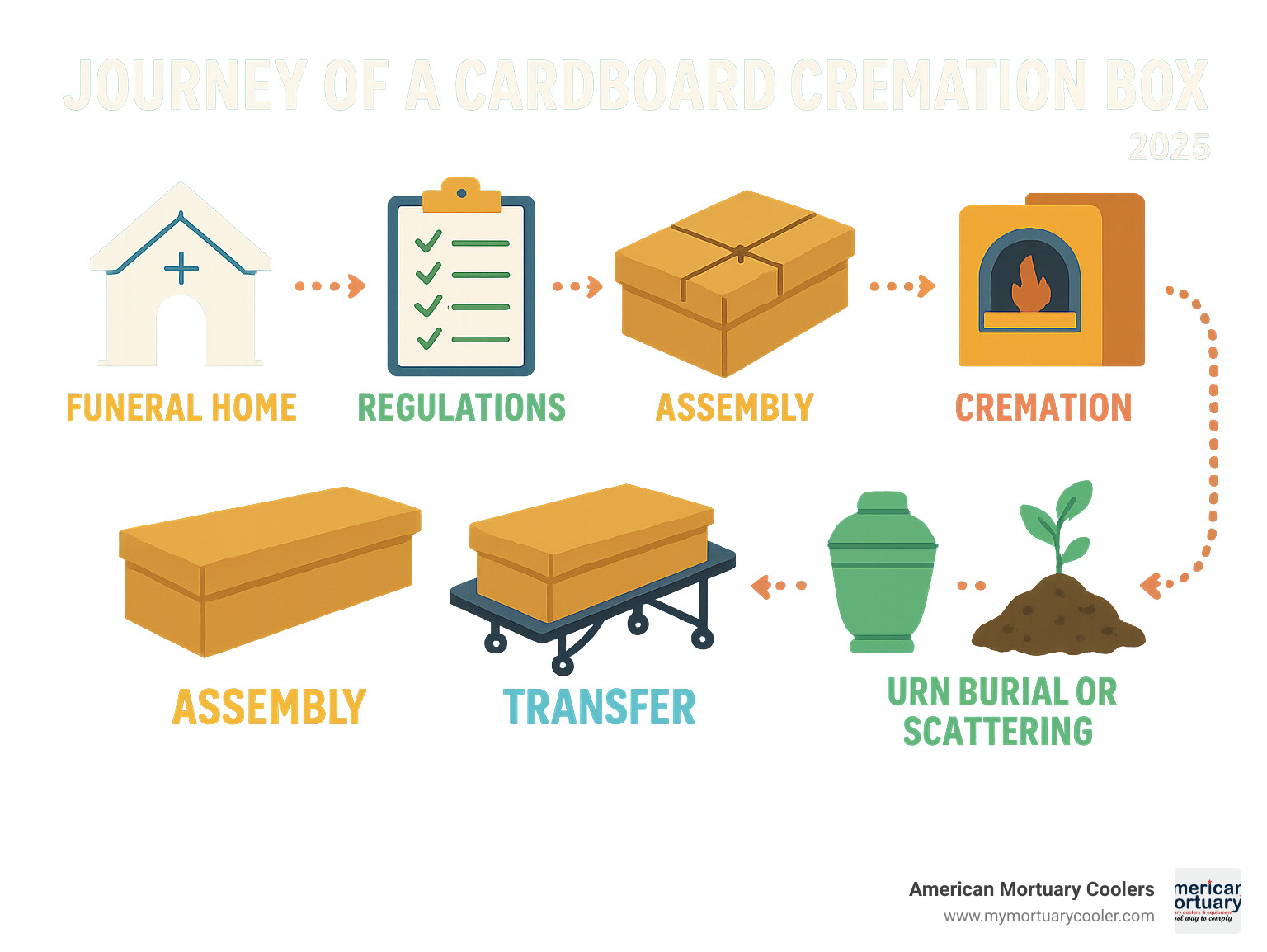
Key cardboard cremation boxes vocabulary:
Cardboard Cremation Boxes: Key Specs & Construction
When choosing cardboard cremation boxes for your funeral home, understanding the technical details makes all the difference. These aren't regular cardboard boxes - they're specially engineered containers built for one of the most important moments in a family's journey.
Cardboard cremation boxes are the reliable workhorses of the cremation industry, made from specialized corrugated brown kraft cardboard chosen for its excellent strength-to-weight ratio.
What makes these containers special? They feature reinforced walls, leak-resistant coatings that prevent accidents, and secure closure systems that give families peace of mind. The Michelman leak-resistant interior coating creates a protective barrier preventing fluid seepage during transport and handling.
The four-corner zip-tie assembly system provides secure, tamper-evident closure without requiring tools. Pre-scored fold lines mean your staff can assemble these containers quickly, even during busy periods.
These boxes ship fold-flat, reducing shipping volume by up to 80%. That means more inventory in less space, translating to better cash flow and fewer warehouse headaches.
Standard Sizes & Limits
Most cardboard cremation boxes follow the industry standard of 76.5" L x 23.5" W x 12" H when assembled, with a weight capacity of 200 lbs for basic single-wall construction.
Oversized options step up to around 79" x 22.5" x 12" H for heavier individuals with increased weight capacity, especially with double-wall construction.
Unassembled dimensions measure approximately 94.75" x 42" x 0.125" when flat. That ultra-thin profile means you can stack dozens of containers in the space that used to hold just a few pre-assembled units.
Strength Tests Demystified
Understanding strength ratings helps you choose the right cardboard cremation boxes for your needs. Two key tests determine performance under pressure.
The Edge Crush Test (ECT) measures top-to-bottom compression strength. Standard single-wall boxes typically rate at ECT 51, meaning they can withstand 51 pounds of pressure per linear inch.
The Burst Test (BT) measures internal and external pressure resistance. Single-wall containers usually rate at #350 BT, while premium double-wall versions reach #750 BT. Higher numbers mean stronger containers.
Wood strip reinforcement adds serious strength to the floor assembly, running along the container's length and distributing weight evenly to prevent sagging during transport.
Special Variants for Pets & Infants
Pet cremation boxes are designed with different proportions to accommodate everything from small cats to large dogs, recognizing that pet families deserve the same care and dignity.
Infant cremation containers require special sensitivity. Child sizes typically measure around 127×89×76 mm, with miniature options at 89×57×44 mm for the tiniest angels. These specialized containers often include additional liner materials for improved presentation.
Color choices include woodgrain, blue, green, burgundy, white, and black finishes. Some manufacturers offer bespoke colors for large orders, allowing funeral homes to maintain brand consistency across all services.
Comparing Cremation Container Materials
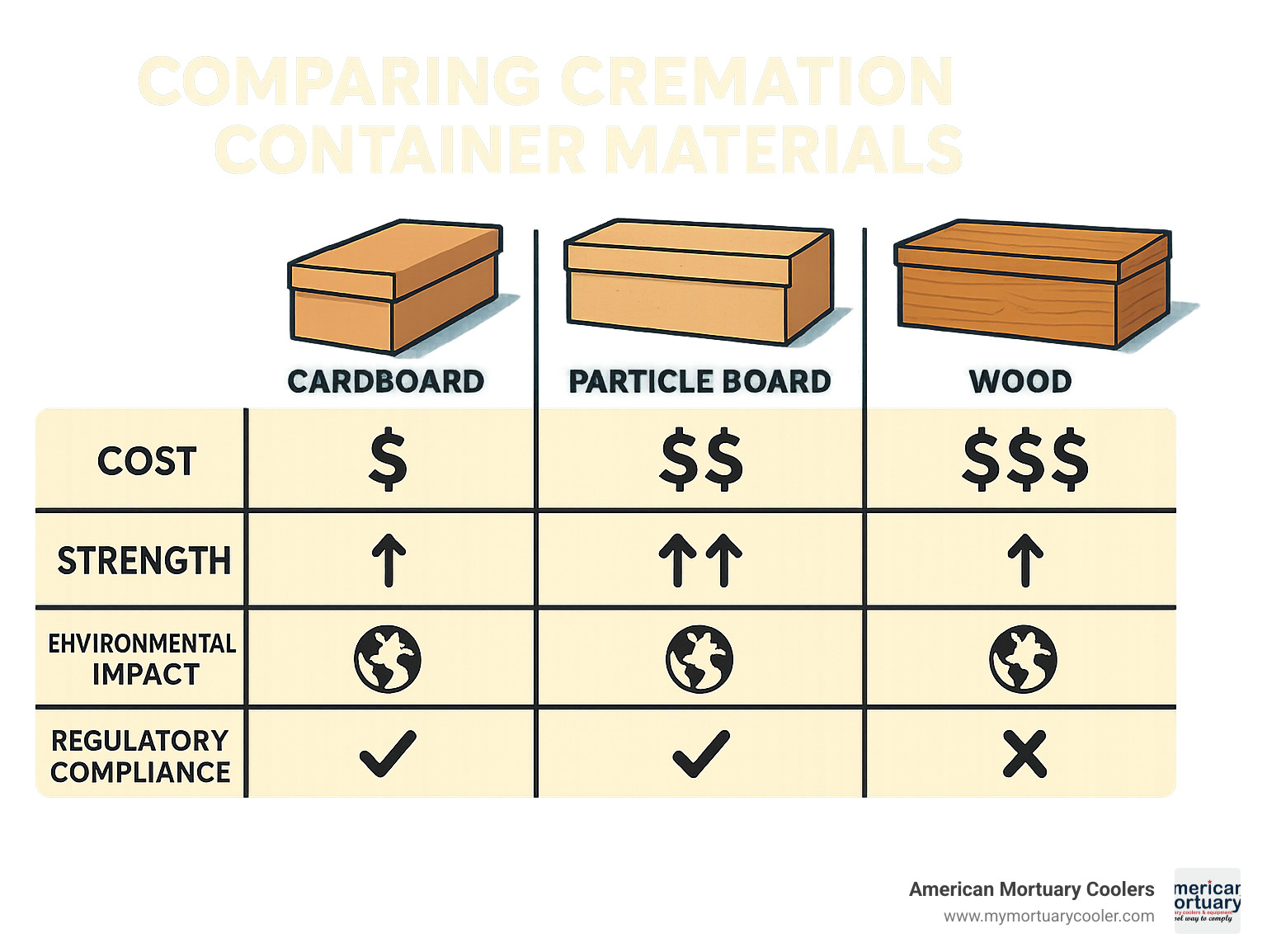
Choosing the right cremation container material can feel overwhelming with so many options available. Cardboard cremation boxes have emerged as a popular choice, but how do they stack up against traditional materials like particle board and wood?
The differences are pretty significant when you dig into the details. Cardboard cremation boxes typically cost between $10-$99 depending on construction quality, while particle board containers range from $190-$345. Wood veneer options can reach $695-$1,195, and metal containers often exceed $500.
But cost isn't everything. Particle board containers offer superior strength for heavier cases, making them ideal when you need maximum durability. A basic particle board container rated for over 200 lbs costs around $345, compared to premium double-wall cardboard cremation boxes at under $100.
Wood veneer containers, particularly those made from paulownia wood, provide an interesting middle ground. They're lightweight, sustainable, and offer a premium appearance that some families prefer. However, the price point puts them out of reach for many budget-conscious operations.
Metal containers deliver the highest strength ratings but come with environmental concerns and significantly higher costs. They're typically reserved for special circumstances or when regulations specifically require metal construction.
Cost & Value Breakdown
The pricing structure for cardboard cremation boxes makes a lot more sense when you understand what drives the costs. Bulk purchasing can bring prices down to as low as $10 per unit for basic single-wall construction, but you'll need to order at least 10 units to qualify.
Retail pricing tells a different story. You'll typically pay around $60 for unlined cardboard containers and up to $99 for premium double-wall models with leak-resistant coatings. The price jump reflects some important upgrades that might be worth the investment.
Wall construction makes the biggest difference in both price and performance. Single-wall containers (#350 BT) handle most standard cases, while double-wall versions (#750 BT) provide extra security for challenging situations. The coating application is another major factor - basic uncoated boxes save money upfront, but Michelman leak-resistant coating can prevent costly problems down the road.
Volume pricing becomes crucial for busy funeral homes. The difference between individual unit pricing and bulk orders can significantly impact your bottom line, especially when you're processing multiple cremations weekly.
Environmental Impact & Sustainability
Here's where cardboard cremation boxes really shine. These containers are completely biodegradable, using paper-based adhesives and tapes that break down naturally in soil. The manufacturing process generates much lower CO₂ emissions compared to wood processing or metal fabrication.
Green burial applications have strict environmental standards, and cardboard cremation boxes meet them beautifully. They contain no metal components, plastic elements, or synthetic materials that could persist in soil for decades. Natural decomposition typically completes within 2-3 years under normal conditions.
The cremation process itself benefits from cardboard's clean-burning properties. Unlike particle board with formaldehyde-based adhesives or metal containers requiring special handling, cardboard burns cleanly with minimal emissions.
This environmental advantage hasn't gone unnoticed. Companies like Loved Remembered Urns have recognized the growing demand for eco-friendly cremation products that align with consumer environmental consciousness.
Legal & Regulatory Checklist
Navigating cremation container regulations doesn't have to be complicated, but you do need to know the key requirements. Cardboard cremation boxes meet legal standards in most jurisdictions, though specific rules vary by location.
British Columbia law specifically requires deceased individuals to be enclosed in a rigid container for cremation, making cardboard containers a legally acceptable minimum standard. Most U.S. states follow similar principles with their own specific requirements.
The essential requirements are straightforward: containers must be rigid and fully enclosed, materials must be combustible for cremation, and there can be no metal components that could damage crematory equipment. Adequate strength for safe handling and leak-resistant construction round out the basic requirements for public health protection.
Airline shipment adds another layer of complexity if you're transporting remains. International shipping requires compliance with destination country regulations, which may include specific requirements for container materials, labeling, and documentation. It's worth checking these requirements early in your planning process to avoid delays or complications.
Buying, Customizing & Logistics
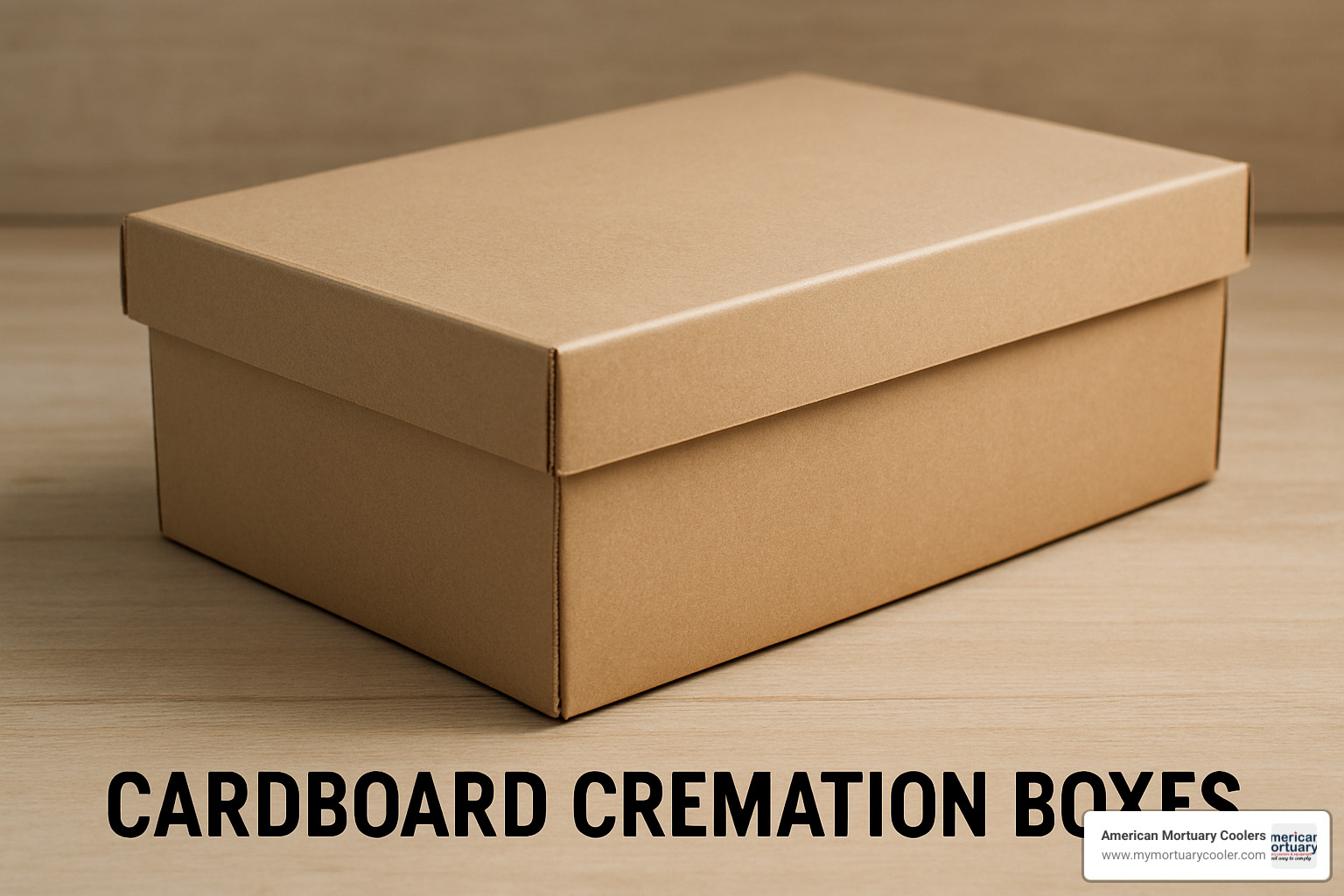
Getting cardboard cremation boxes isn't like ordering office supplies online. Most suppliers require 10 units minimum for bulk pricing, though some offer 2-packs for smaller funeral homes.
The fold-flat design really shines here. You can store 50 unassembled boxes in the same space that five assembled ones would take, allowing you to take advantage of bulk pricing without turning your prep room into a cardboard warehouse.
Lead times are typically 5-7 days for standard boxes, but custom orders require 12-15 days. Rush orders cost extra.
Custom Printing & Branding
Custom printing has become sophisticated for cardboard cremation boxes. You can add your funeral home logo, use Pantone color matching, and even get embossing for a premium look.
The catch? You need at least 500 pieces for custom printing due to setup costs. Interior printing is a discrete option that reinforces your professional image when containers are opened.
Purchasing Workflow
Licensed funeral homes, crematories, cemeteries, medical schools, and coroner offices can purchase directly. Individual families must work through funeral homes.
Most suppliers use online ordering systems with real-time inventory and automatic volume pricing. Payment terms are usually net 30 for established accounts.
Price Drivers to Watch
Construction choices make the biggest difference. Double-wall construction costs more than single-wall. Leak-resistant coating, wood strip reinforcement, and premium closure hardware are upgrades that provide real value.
Size matters - oversized containers cost more than standard dimensions. Color options beyond basic brown kraft increase costs. Custom printing has its own pricing tier, and rush delivery comes with premium charges.
Don't forget add-ons: extra tie straps, interior liners, and identification tags all cost extra but can add up quickly.
Assembly, Handling & Best Practices for Cardboard Cremation Boxes
Cardboard cremation boxes are designed so one person can assemble them safely. Store them flat in climate-controlled areas - moisture is cardboard's enemy. Stack no more than 10 units high to prevent bent corners and damaged fold lines.
Step-by-Step Assembly Guide for Cardboard Cremation Boxes
Clear an 8-foot workspace before starting. Check container size and inspect for shipping damage.
Start by locating pre-scored fold lines on the base section. Unfold the base carefully along the creases. Form corners by aligning corner tabs - patience prevents wobbly containers.
If your box includes wood strip reinforcement, slide strips along the base length before securing. Secure the base with zip ties at corner attachment points and test stability.
Install the leak-proof liner so it extends slightly beyond container edges - this overhang prevents seepage during transport.
Transport & Storage Tips
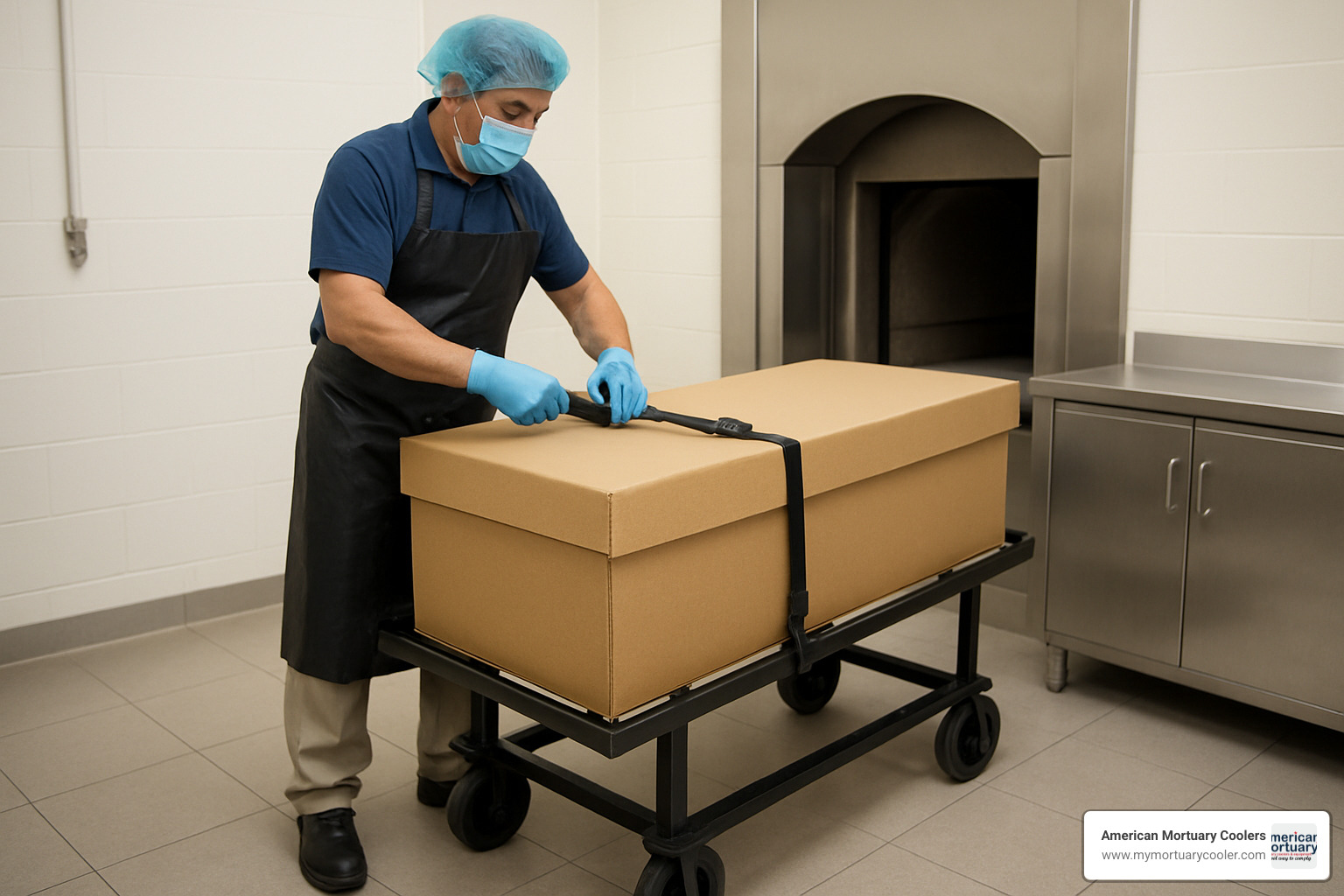
Once loaded, use four-wheel dollies rated for appropriate weight capacity. During vehicle transport, secure containers with straps that distribute load evenly across the base.
Never stack loaded containers. Maintain climate control during extended transport and plan routes to minimize handling. For temporary storage, refrigeration becomes necessary.
Disposal After Cremation
Clean containers can enter standard cardboard recycling programs. Commercial composting works well since all materials break down naturally. Energy recovery through incineration provides useful energy while keeping materials out of landfills.
Throughout their lifecycle, cardboard cremation boxes maintain a smaller environmental footprint compared to traditional alternatives.
Frequently Asked Questions about Cardboard Cremation Boxes
When funeral directors first consider switching to cardboard cremation boxes, they often have the same three questions. Let me address these concerns based on years of experience helping funeral homes make this transition successfully.
Are cardboard cremation boxes strong enough for heavier bodies?
This is probably the most common concern I hear, and I completely understand why. When you're used to heavy wooden containers, cardboard can seem fragile. But here's what might surprise you: cardboard cremation boxes are engineered specifically for this purpose and can absolutely handle heavier individuals safely.
Standard single-wall containers work perfectly for cases up to 200 pounds. But when you need more capacity, double-wall construction changes everything. These containers feature #750 BT ratings with wood strip reinforcement, giving you strength that rivals particle board alternatives at a fraction of the cost.
For larger cases, oversized dimensions of 79" x 22.5" x 12" provide the extra space needed while maintaining full structural integrity. The secret is in the engineering - these aren't just oversized shipping boxes. They're purpose-built cremation containers with reinforced floors and secure zip-tie closure systems.
The key is proper handling. Use mechanical lifting aids, ensure your transport dollies are rated appropriately, and follow standard handling procedures. When you do this, the container performs beautifully regardless of the weight involved.
Can they be used for green burials?
Absolutely, and they're actually one of the best choices available for green burial applications. Cardboard cremation boxes meet every environmental standard required by natural burial grounds and green cemeteries.
What makes them perfect for green burials is what they don't contain. No metal components, no synthetic adhesives, no plastic elements - nothing that persists in soil. The paper-based adhesives and natural tape materials break down completely within 2-3 years under normal soil conditions.
Many green burial sites actually recommend cardboard over traditional wood alternatives. The reason? Faster decomposition rates and significantly lower environmental impact during manufacturing. You won't find any stains, varnishes, or metal hardware that could potentially contaminate soil.
This aligns perfectly with green burial principles of returning to earth naturally. Families choosing this path appreciate knowing their container choice supports their environmental values from start to finish.
How do cardboard cremation boxes differ from cardboard urns or scattering tubes?
This confusion comes up regularly, and it's completely understandable since they're all made from similar materials. But they serve completely different purposes in the cremation process.
Cardboard cremation boxes are designed to hold human remains during the cremation process itself. They're large containers - 76 inches long - built for strength and leak resistance. Think of them as the vehicle that safely transports someone through cremation.
Cardboard urns, on the other hand, are much smaller containers (typically under 12 inches tall) designed to hold cremated ashes afterward. They focus on presentation and may serve as temporary storage until families select permanent urns. These usually cost around $45 and provide an economical holding solution.
Scattering tubes are even more specialized. They're designed specifically for ash dispersal, often featuring perforated sections for controlled release. Some are even airport-ready for families who want to travel with ashes for scattering ceremonies.
The capacity difference tells the whole story: cremation boxes accommodate full human remains, while urns typically hold around 200 cubic inches of cremated ashes. They're partners in the cremation process, but they serve very different roles.
Conclusion
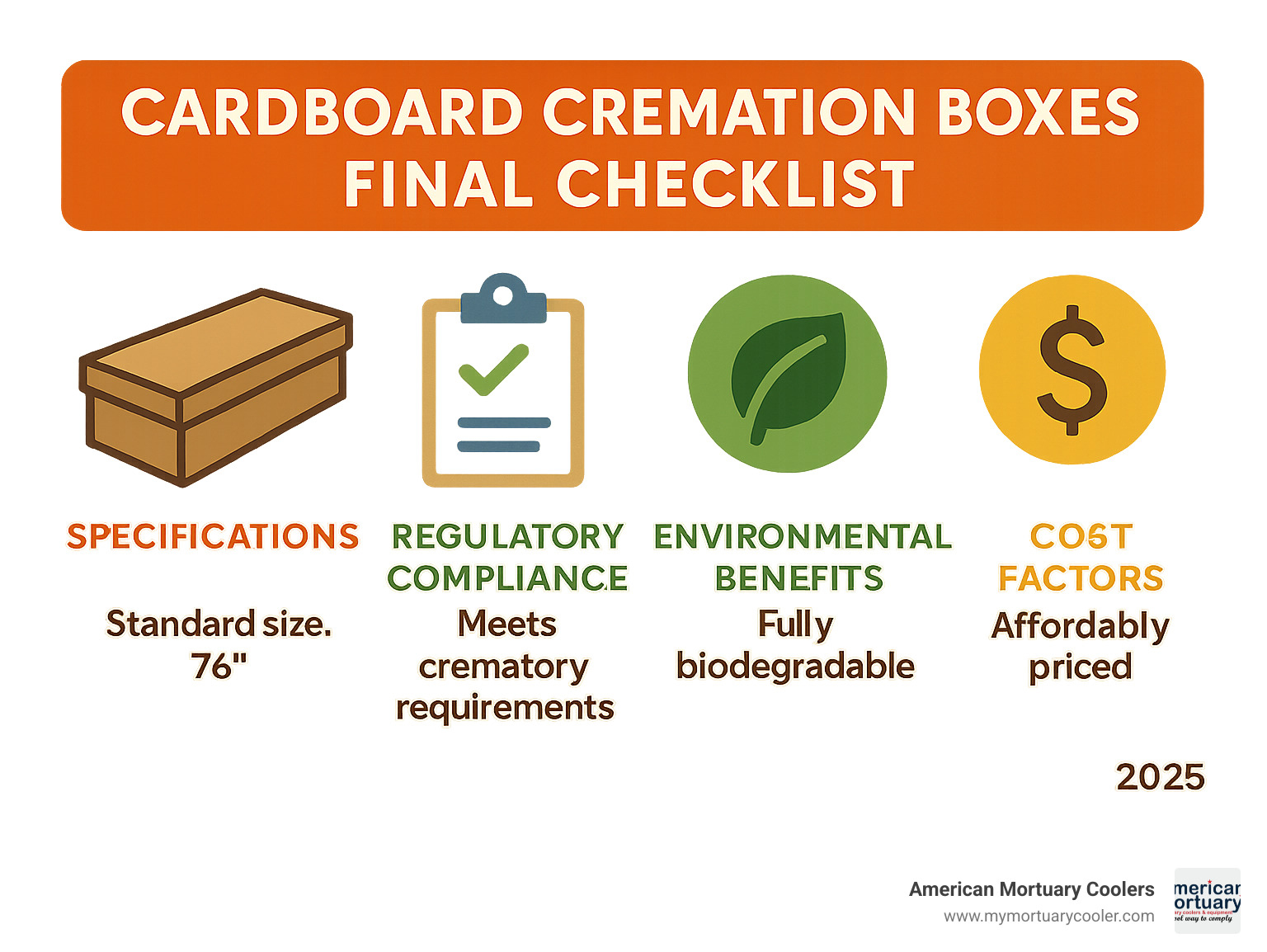
Choosing cardboard cremation boxes for your funeral home isn't just about saving money – though the cost savings are impressive. It's about making a smart business decision that aligns with where the industry is heading.
The numbers speak for themselves. With cremation rates climbing past 56% nationwide, funeral homes need containers that balance cost-effectiveness with professional standards. When you can get quality cardboard containers for $10-99 versus $300-1,000 for traditional alternatives, the math becomes pretty clear.
But it's not just about the bottom line. Today's families increasingly care about environmental impact, and cardboard cremation boxes deliver on that front. They're completely biodegradable, burn cleanly during cremation, and meet green burial requirements without compromise. That's a conversation starter that can set your funeral home apart.
The practical benefits matter too. These containers ship flat to save storage space, assemble quickly with one person, and meet all regulatory requirements from British Columbia to your local jurisdiction. The leak-resistant coatings and secure zip-tie closures provide the reliability you need for professional service.
Here's what successful funeral homes focus on when making the switch: verify your size requirements (standard 76.5" works for most cases), choose appropriate wall strength (single-wall for budget, double-wall for premium), and calculate your volume needs to maximize bulk pricing. Don't forget to factor in lead times – especially if you want custom branding.
The environmental story gets stronger every year. Families want sustainable options, and cardboard cremation boxes deliver without asking them to sacrifice dignity or quality. Complete biodegradability, reduced manufacturing emissions, and compatibility with natural burial grounds make these containers a forward-thinking choice.
At American Mortuary Coolers, we've seen how the right equipment choices can transform a funeral home's operations. Our experience serving funeral homes across Tennessee and throughout the contiguous 48 states has taught us that success comes from balancing quality, cost, and service reliability.
The cremation industry is evolving rapidly, and cardboard cremation boxes represent where it's heading – toward sustainable, economical solutions that maintain professional standards. Getting ahead of this trend positions your funeral home as both environmentally conscious and financially savvy.
Starting small makes sense. Order a trial quantity to test your supplier's quality and service before committing to larger inventory investments. This approach lets you make informed decisions without tying up capital or storage space.
The future belongs to funeral homes that can offer competitive cremation packages while maintaining healthy margins. Cardboard cremation boxes provide that flexibility, whether you're serving budget-conscious families or those seeking eco-friendly options.
Ready to explore how the right cremation container can improve your operations? More info about choosing the right cremation container dives deeper into matching container specifications with your specific needs.



